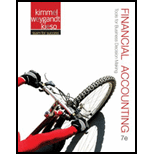
(a-1)
Bonds
Bonds are a kind of interest bearing notes payable, usually issued by companies, universities and governmental organizations. It is a debt instrument used for the purpose of raising fund of the corporations or governmental agencies. If selling price of the bond is equal to its face value, it is called as par on bond. If selling price of the bond is lesser than the face value, it is known as discount on bond. If selling price of the bond is greater than the face value, it is known as premium on bond.
Straight-line amortization bond
Effective interest rate of amortization bond
Effective interest rate method of amortization is a process of amortizing premium on bond or discount on bond, which allocates the different amount of interest expense in each period of interest payment, but a constant percentage rate.
To Prepare: The
(a-2)
To Prepare: The journal entry to record the accrued interest expense and premium on amortize bond for Company M on December 31, 2014.
(a-3)
To Prepare: The journal entry to record the payment of interest of Company M on January 1, 2015.
(a-4)
To Prepare: The journal entry to record the accrued interest expense and discount on amortize bond for Company M on December 31, 2015.
(b)
To Prepare: The proper long-term liabilities section
(c-1)
To Prepare: The interest expenses amount shows in the year 2015 of Company M.
(c-2)
To Ascertain: If the bond interest expense reported in the year 2015 is greater than the amount reported, lesser than the amount reported or same amount reported, if the Company used the straight-line method of amortization.
Want to see the full answer?
Check out a sample textbook solution
Chapter 10 Solutions
Financial Accounting
- Please solve this question general accountingarrow_forwardWhat is the level of its accounts receivable on these general accounting question?arrow_forwardFor the following scenarios, off-set the losses for the appropriate years using the rules as applied in Trinidad and Tobago and those in Jamaica: In the year of assessment 2012, Company McKenzie Incor. Ltd has PYL of $3,800,000 to its disposal. In 2013 the company made net income of $4,700,000 and 3,800,000 in 2014.arrow_forward

 AccountingAccountingISBN:9781337272094Author:WARREN, Carl S., Reeve, James M., Duchac, Jonathan E.Publisher:Cengage Learning,
AccountingAccountingISBN:9781337272094Author:WARREN, Carl S., Reeve, James M., Duchac, Jonathan E.Publisher:Cengage Learning, Accounting Information SystemsAccountingISBN:9781337619202Author:Hall, James A.Publisher:Cengage Learning,
Accounting Information SystemsAccountingISBN:9781337619202Author:Hall, James A.Publisher:Cengage Learning, Horngren's Cost Accounting: A Managerial Emphasis...AccountingISBN:9780134475585Author:Srikant M. Datar, Madhav V. RajanPublisher:PEARSON
Horngren's Cost Accounting: A Managerial Emphasis...AccountingISBN:9780134475585Author:Srikant M. Datar, Madhav V. RajanPublisher:PEARSON Intermediate AccountingAccountingISBN:9781259722660Author:J. David Spiceland, Mark W. Nelson, Wayne M ThomasPublisher:McGraw-Hill Education
Intermediate AccountingAccountingISBN:9781259722660Author:J. David Spiceland, Mark W. Nelson, Wayne M ThomasPublisher:McGraw-Hill Education Financial and Managerial AccountingAccountingISBN:9781259726705Author:John J Wild, Ken W. Shaw, Barbara Chiappetta Fundamental Accounting PrinciplesPublisher:McGraw-Hill Education
Financial and Managerial AccountingAccountingISBN:9781259726705Author:John J Wild, Ken W. Shaw, Barbara Chiappetta Fundamental Accounting PrinciplesPublisher:McGraw-Hill Education





